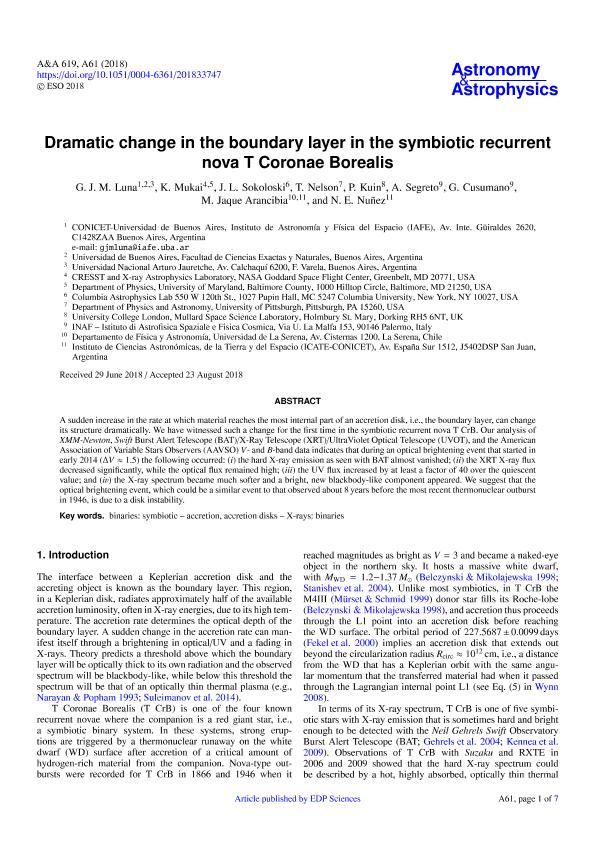Artículo
Dramatic change in the boundary layer in the symbiotic recurrent nova T Coronae Borealis
Luna, Gerardo Juan Manuel ; Mukai, K.; Sokoloski, J. L.; Nelson, T.; Kuin, P.; Segreto, A.; Cusumano, Julio Ricardo; Jaque Arancibia, Marcelo Daniel
; Mukai, K.; Sokoloski, J. L.; Nelson, T.; Kuin, P.; Segreto, A.; Cusumano, Julio Ricardo; Jaque Arancibia, Marcelo Daniel ; Nuñez, Natalia Edith
; Nuñez, Natalia Edith
 ; Mukai, K.; Sokoloski, J. L.; Nelson, T.; Kuin, P.; Segreto, A.; Cusumano, Julio Ricardo; Jaque Arancibia, Marcelo Daniel
; Mukai, K.; Sokoloski, J. L.; Nelson, T.; Kuin, P.; Segreto, A.; Cusumano, Julio Ricardo; Jaque Arancibia, Marcelo Daniel ; Nuñez, Natalia Edith
; Nuñez, Natalia Edith
Fecha de publicación:
11/2018
Editorial:
EDP Sciences
Revista:
Astronomy and Astrophysics
ISSN:
0004-6361
Idioma:
Inglés
Tipo de recurso:
Artículo publicado
Clasificación temática:
Resumen
A sudden increase in the rate at which material reaches the most internal part of an accretion disk, i.e., the boundary layer, can change its structure dramatically. We have witnessed such a change for the first time in the symbiotic recurrent nova T CrB. Our analysis of XMM-Newton, Swift Burst Alert Telescope (BAT)/X-Ray Telescope (XRT)/UltraViolet Optical Telescope (UVOT), and the American Association of Variable Stars Observers (AAVSO) V- and B-band data indicates that during an optical brightening event that started in early 2014 (ΔV ≈ 1.5) the following occurred: (i) the hard X-ray emission as seen with BAT almost vanished; (ii) the XRT X-ray flux decreased significantly, while the optical flux remained high; (iii) the UV flux increased by at least a factor of 40 over the quiescent value; and (iv) the X-ray spectrum became much softer and a bright, new blackbody-like component appeared. We suggest that the optical brightening event, which could be a similar event to that observed about 8 years before the most recent thermonuclear outburst in 1946, is due to a disk instability.
Palabras clave:
ACCRETION, ACCRETION DISKS
,
BINARIES: SYMBIOTIC
,
X-RAYS: BINARIES
Archivos asociados
Licencia
Identificadores
Colecciones
Articulos(IAFE)
Articulos de INST.DE ASTRONOMIA Y FISICA DEL ESPACIO(I)
Articulos de INST.DE ASTRONOMIA Y FISICA DEL ESPACIO(I)
Articulos(ICATE)
Articulos de INST.D/CS ASTRONOMICAS D/LA TIERRA Y DEL ESPACIO
Articulos de INST.D/CS ASTRONOMICAS D/LA TIERRA Y DEL ESPACIO
Citación
Luna, Gerardo Juan Manuel; Mukai, K.; Sokoloski, J. L.; Nelson, T.; Kuin, P.; et al.; Dramatic change in the boundary layer in the symbiotic recurrent nova T Coronae Borealis; EDP Sciences; Astronomy and Astrophysics; 619; 11-2018; 61-68
Compartir
Altmétricas



